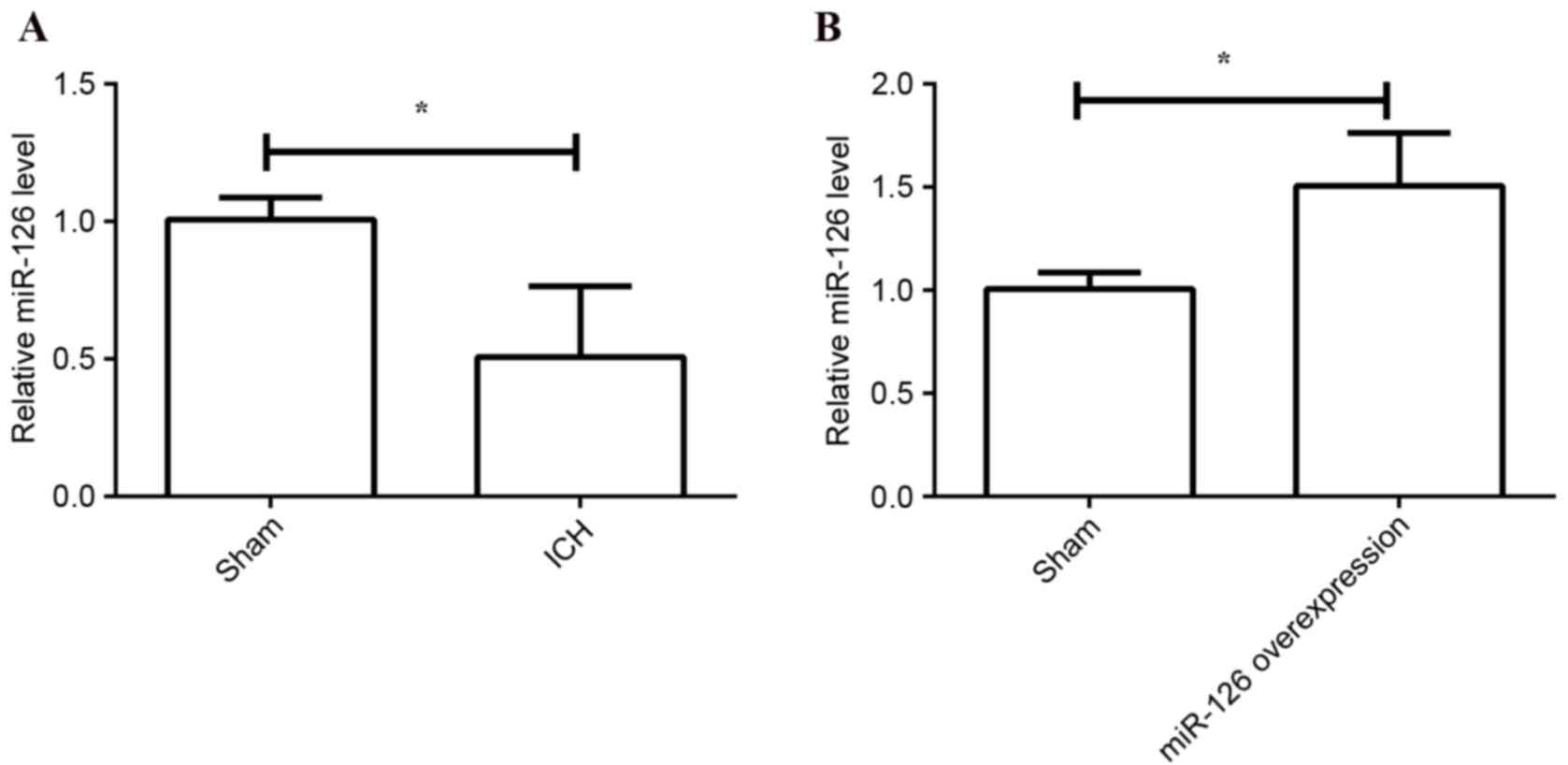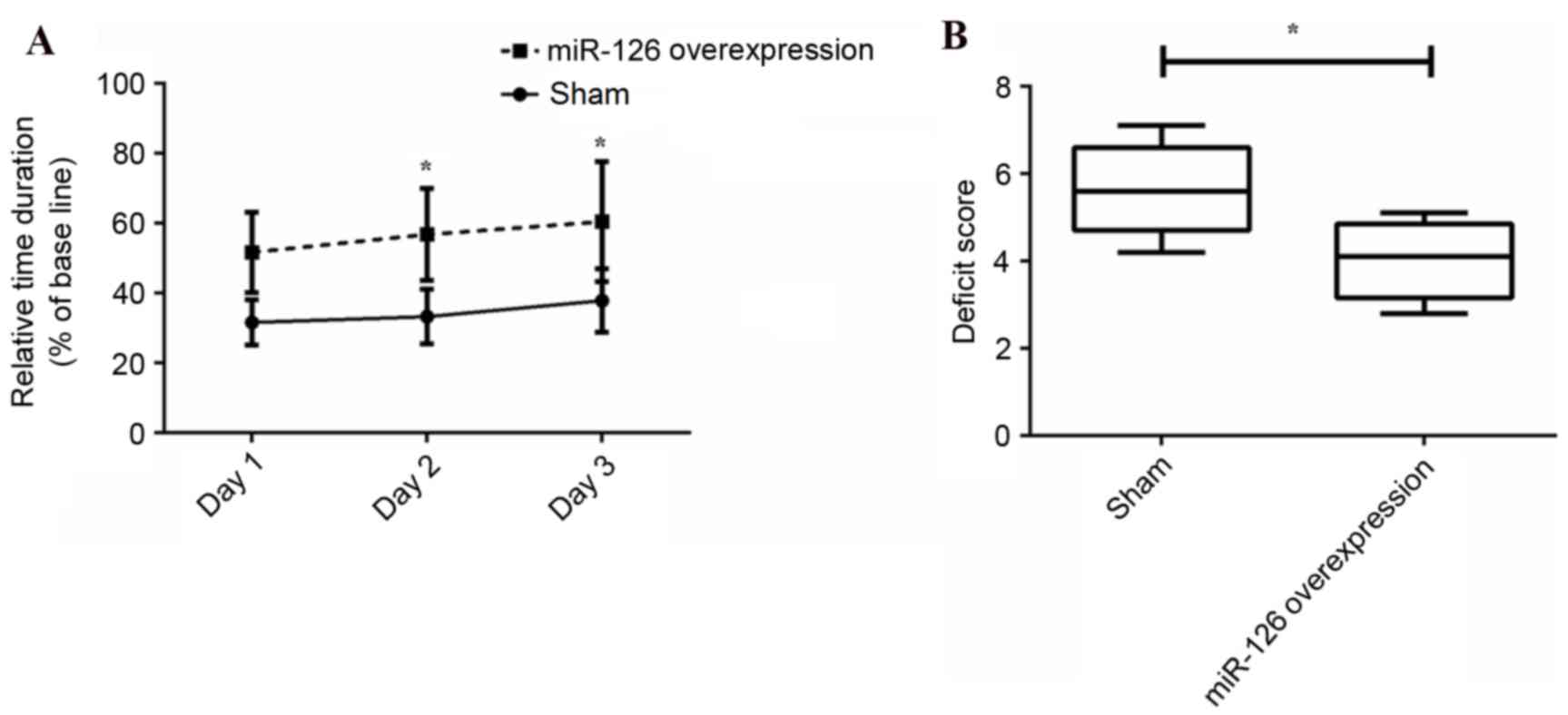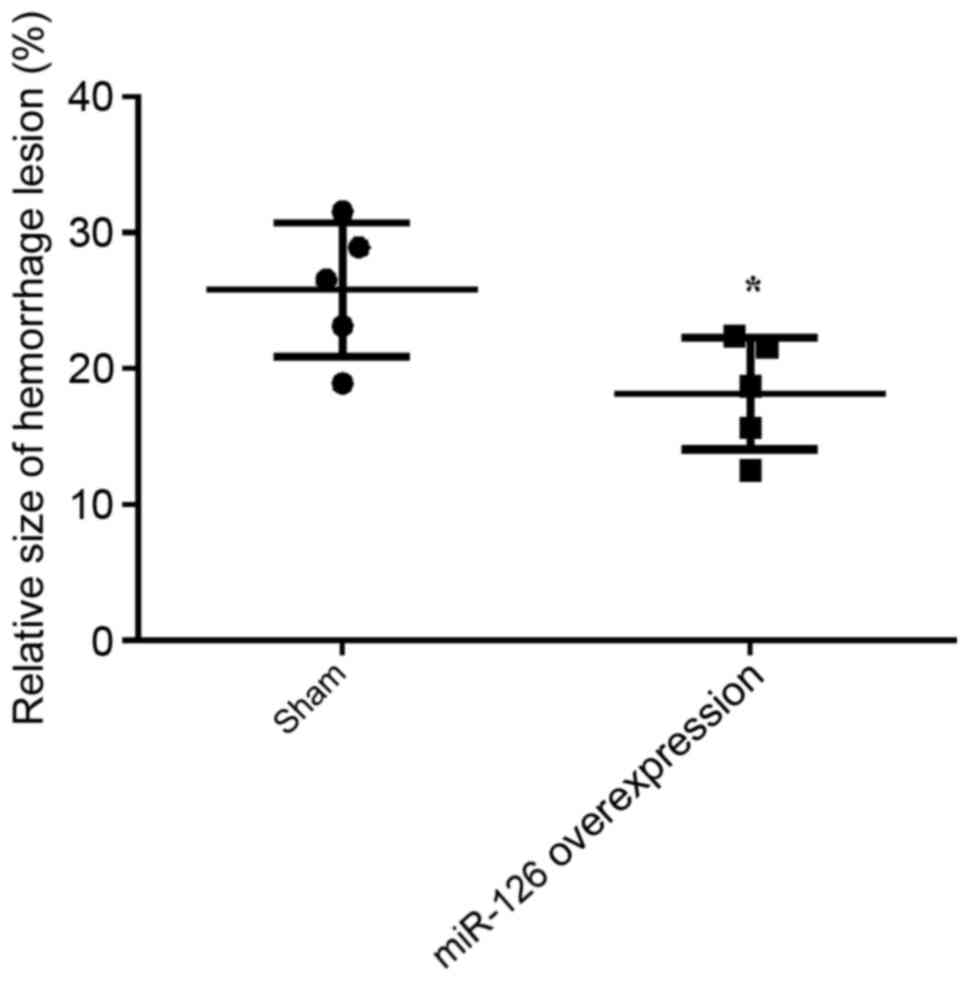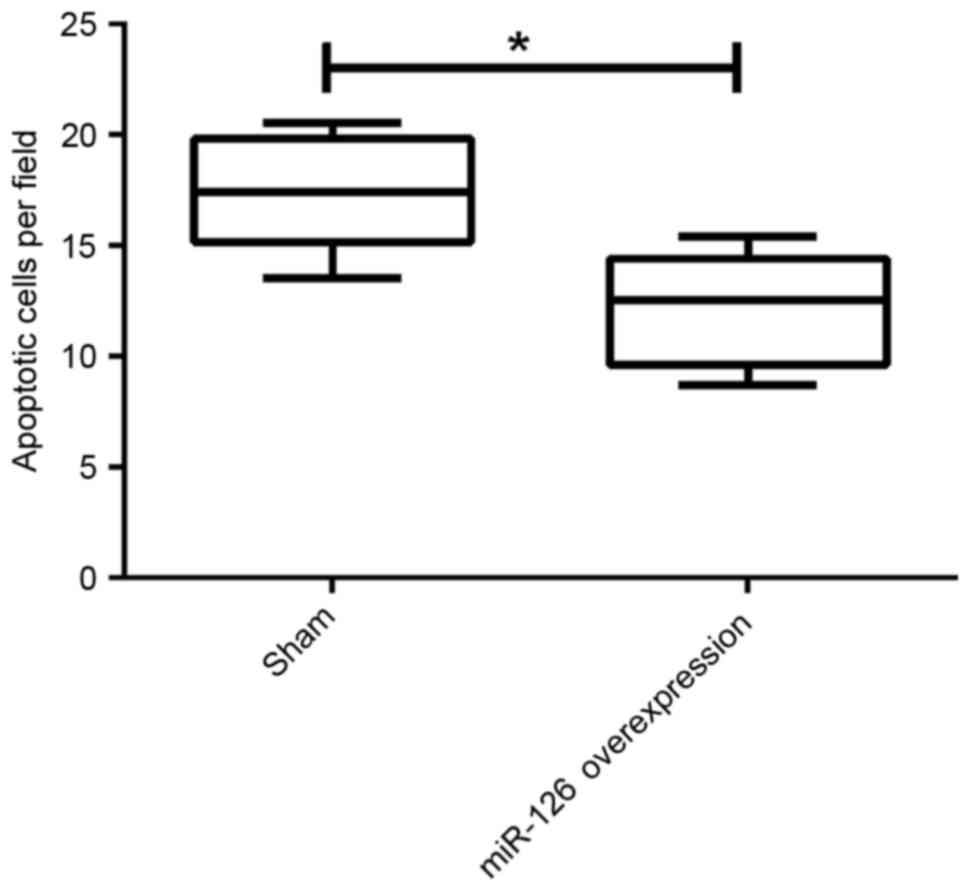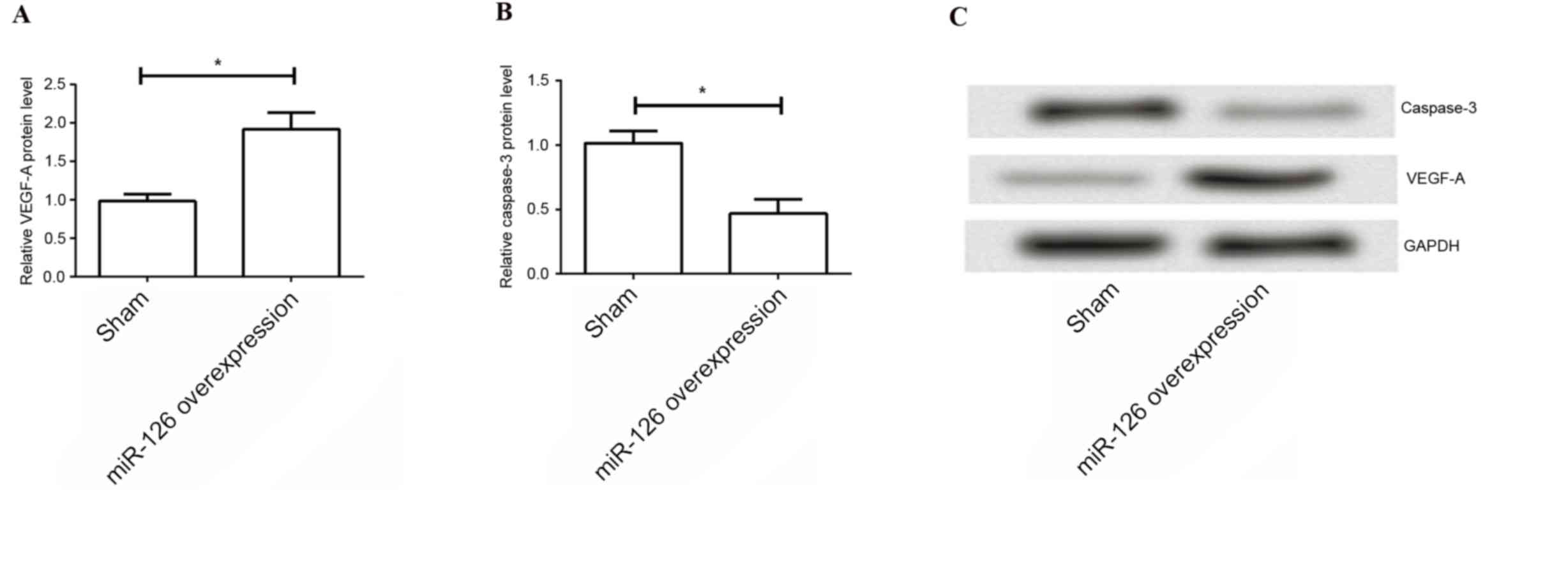Protective role of microRNA-126 in intracerebral hemorrhage
- Authors:
- Published online on: January 19, 2017 https://doi.org/10.3892/mmr.2017.6134
- Pages: 1419-1425
Abstract
Introduction
Intracerebral hemorrhage (ICH) is a condition associated with poor prognosis and high mortality ranging from 25–50% (1). It is the most severe subtype of stroke and accounts for 10–15% of all cases of stroke in the majority of western populations (2), and up to 55% in China (3). This disease may occur at all ages, however it affects younger people more frequently than ischemic strokes. Although progress has been made in recent years in understanding the complex pathogenesis of ICH, a major challenge remains in the search for an effective therapeutic treatment for ICH. Various novel treatment strategies, including stem cell therapy, are experimental and have not proven successful in clinical trials. Current therapeutic strategies for ICH remain inadequate, therefore, a novel treatment approach based on the pathogenic mechanism of ICH is of primary concern.
MicroRNAs (miRNAs) are a group of small short sequence (18–25 nucleotides) non-coding RNAs that negatively regulate target gene expression by translational inhibition and/or mRNA degradation (4,5). It has previously been demonstrated that miRNAs are important in numerous biological and pathological processes, including cell proliferation, differentiation, apoptosis and migration (6). The expression of miRNAs is involved in the development of a variety of human diseases including ICH, and multiple prior studies have acknowledged the potential therapeutic uses of miRNAs in the treatment of diseases (7–9). Of all the miRNAs, miRNA-126 (miR-126) is a significant regulator of angiogenic signaling in endothelial cells and is important in vascular integrity, cancer growth and invasion and vascular inflammation (10–13). It has been reported that miR-126 is involved in atherosclerosis and exhibits an anti-atherogenic role by enhancing endothelial repair (14). Regarding cerebral ischemia, angiogenesis is regarded as a natural protective mechanism and has been reported to be involved in collagenase-induced ICH (15). Therefore, targeting angiogenesis may be a feasible therapeutic approach for the treatment of ICH.
The present study assessed miR-126 expression in a rat model of ICH induced by collagenase to elucidate the distinct underlying pathogenic mechanism of ICH. In addition, the study aimed to identify potential therapeutic targets of ICH by miRNA modulation.
Materials and methods
Animals and experimental designs
Adult male Wistar rats (n=12; Laboratory Animal Center of Sun Yat-Sen University, Zhuhai, China) weighing between 320 and 350 g (12-weeks-old) were used in the present study. All the animals were acclimated to the laboratory for ≥1 week prior to testing. The rats were housed in separate cages with standard food and water ad libitum under 12:12 h light-dark cycle with a controlled temperature ranging between 20 and 22°C, and 50 and 65% humidity. The animal experiments were performed in accordance with the Principles of Laboratory Animal Care and approved by the Ethics Committee of The Fifth Affiliated Hospital of Sun Yat-Sen University (approval no. IACUC-15-083, Zhuhai, China). The rats were randomly assigned to ICH model and sham groups.
ICH model
ICH was induced by intracerebral injection of collagenase in accordance with the previously described protocol (16,17). Briefly, the rats in the ICH model group (n=6) were anesthetized with 2% isoflurane (Sigma-Aldrich; Merck Millipore, Darmstadt, Germany) and were placed into a stereotaxic frame. Collagenase VIIS (0.075 U/500 nl saline; Sigma-Aldrich, Merck Millipore, Darmstadt, Germany) was then injected unilaterally into the caudate putamen for 5 min with a glass syringe at the following stereotactic coordinates: 1.0 mm posterior to and 2.2 mm lateral to the bregma, and 6.0 mm in depth below the skull. Following injection, the needle was held in the injection site for a further 10 min to prevent reflux. During the surgery and the recovery periods, rectal temperature was maintained at 37±0.5°C. The rats in the sham group (n=6) were administered an equal volume of saline without collagenase VIIS. ICH was considered to occur when the hematoma appeared in the caudate nucleus.
Vector construction and transduction
The miR-126 lentivirus expression vector (pWPXL-miR-126) and negative control vector (Shanghai GenePharma Co., Ltd., Shanghai, China) was constructed by replacing the pWPXL vector green fluorescence protein (GFP) fragment with the pri-miR-126 sequence amplified from normal genomic DNA. The oligonucleotide sequences for pri-miR-126 sequence were as follows: Forward 5′-AATTATATCTCGAGGAGGGAGGATAGGAAT0AAT1-3′ and reverse 5′-GCTCGAATTCCAGAGGTCTCAGGGCTATGC-3′. The constructs were verified by sequencing. Lentivirus expression plasmids were co-transfected into HEK293T cells using Lipofectamine 3000 reagent (Invitrogen; Thermo Fisher Scientific, Inc., Waltham, MA, USA) following the manufacturer's protocol. HEK293T cells were obtained from Cell Bank of Chinese Academy of Sciences (Shanghai, China). These cells were cultured in Dulbecco's modified Eagle's medium (DMEM; Invitrogen; Thermo Fisher Scientific, Inc.) supplemented with 10% fetal bovine serum (Gibco; Thermo Fisher Scientific, Inc.), penicillin (100 U/ml) and streptomycin (100 µg/ml). The titers of lentivirus vector stocks were 0.4×109-2.0×109 particles/ml. The lentivirus vectors were delivered via intraparenchymal injection of rats as described previously (18), with slight modification (19). Briefly, the rats were anesthetized by 400 mg/kg chloral hydrate (Sigma-Aldrich; Merck Millipore) and the spine was held with two individual bars placed around the L3 vertebra. Subsequently, the thoracic T13 vertebra was drilled away to provide access to the left side of the lumbar spinal cord with the use of an operation microscope (Zeiss GmbH, Jena, Germany Pentero). The dura mater and arachnoid mater were then exposed intact, and lentivirus vectors [LV-Enhanced GFP or LV-miR-126] were delivered by using an automatic microinjection device (KDS 310; KD Scientific, Inc., Holliston, MA, USA) followed by suture of the muscles and skin. Following the operation, the rats were housed in individual cages for recovery.
Behavioral testing
Behavioral tests were performed at 1, 2 and 3 days following transduction with LV-miR-126 to induce the overexpression of miR-126, and evaluated by the rotarod and limb placement tests. For the rotarod test, the rats were placed on an accelerating rotarod cylinder and trained for 3 days prior to ICH surgery. The speed was slowly increased (ranging from 10 to 40 rpm) within 2 min. Following transduction, the animals were put on the accelerating rod again, and the duration of stay on the rotarod was recorded. The duration was measured three times. The test ended if the rats fell off the rungs or gripped the device and spun around for 2 consecutive revolutions without attempting to walk on the rungs. The limb placement test was performed to assess the sensorimotor integration of forelimbs and hindlimb responses to tactile and proprioceptive stimulation. The limb placement test had three tasks, including ‘visual forward’, ‘visual lateral’ and ‘proprioception’. Visual forward was used to observe the forelimb flexion. The stretch of the forelimbs was assessed as normal stretch (0 point) and abnormal flexion (1 point). Visual lateral was performed to observe the forelimb stretch by stimulating the whiskers when the rat's trunk was held. The evaluations were defined as normal lifting (0 point), abnormal lifting (1, 2, or 3 points). Proprioception was estimated by observation of the rat stepping up on forelimbs and hindlimbs onto the table following a pull-down of the forelimbs and hindlimbs below the table surface. The score was classed to 0 point (normal lifting) 1, 2, or 3 points (abnormal lifting) based on the number of normal stretches.
Evaluation of hemorrhage
The rats were sacrificed three days following transduction under anesthesia with ketamine injection (100 mg/kg; Sigma-Aldrich; Merck Millipore) via cervical dislocation. The brains were immediately harvested and frozen. Coronal slices (embedded in paraffin and cut into 20 µm thick sections) were prepared according to Paxinos and Watson's stereotaxic atlas (20). Hemorrhages were evaluated by blind histological evaluation on three defined sections (+0.48, −0.92 and −3.30 mm relative to the bregma) (21). The incidence of ICH was calculated according to a previously described protocol (22). No hemorrhage was recorded as 0, multiple, macroscopically visible hemorrhages were considered as 1 and hematoma was regarded as 2. Determination of ICH severity was based on the number of petechial hemorrhages or hematoma per infarct area.
Measurement of apoptotic cells
The apoptotic cells were evaluated by terminal transferase deoxyuridine 5′-triphosphate nick end labeling (TUNEL) assay using an in situ cell death detection kit (Roche Diagnostics, Basel, Switzerland) according to the manufacturer's protocol. Briefly, the brain tissue specimens were collected, perfused with 4% paraformaldehyde, deparaffinized, dehydrated, pretreated with proteinase K and peroxidase block (Dako North America, Inc., Carpinteria, CA, USA) and incubated with TdT enzyme at 37°C for 1 h. Subsequently, the sections were washed, incubated with treptavidin-horseradish peroxidase for 15 min, washed again and then incubated with diaminobenzidine (DAB). The number of TUNEL-positive cells were counted using an Olympus microscope (BX45-92P05; Olympus Corporation, Tokyo, Japan) at 10 randomly selected fields.
Reverse transcription-quantitative polymerase chain reaction. (RT-qPCR)
The mRNA levels of miR-126 in the cortical homogenates were determined by RT-qPCR. Briefly, total RNA was extracted with TRIzol® reagent (Invitrogen; Thermo Fisher Scientific, Inc.) from the brain tissue specimens according to the manufacturer's protocols. First-strand complementary DNA (cDNA) was synthesized with the TaqMan microRNA Reverse Transcription Kit (Applied Biosystems, Thermo Fisher Scientific, Inc.) and Megaplex RT primers (Megaplex RT Rodent Pool A; Thermo Fisher Scientific, Inc.). The primers were synthesized by Shanghai Sangon Biotechnology Co., Ltd (Shanghai, China) and the sequences were as follows: iR-126, forward 5′-TATAAGATCTGAGGATAGGTGGGTTCCCGAGAACT-3′ and reverse 5′-ATATGAATTCTCTCAGGGCTATGCCGCCTAAGTAC-3′; U6, forward 5′-ATCCGCAAAGACCTGT-3′ and reverse 5′-GGGTGTAACACTAAG-3′. The relative expression levels were determined using the PrimeScript RT Reagent kit (Takara Bio, Inc., Otsu, Japan) and the 2−ΔΔCq method (23). PCR was run on a GeneAmp PCR System 9700 thermal cycler (Applied Biosystems; Thermo Fisher Scientific, Inc.) under the following parameters: 1 predenaturation cycle of 5 min at 95°C, 40–50 cycles of 95°C for 30 sec, 58–62°C for 30 sec, and 72°C for 30 sec, and a final extension at 72°C for 5 min. U6 snRNA served as a reference gene miRNA expression.
Western blotting
Total protein was extracted from the brain tissue specimens using a protein extract kit (Cytoplasmic Protein Extraction Kit; Wuhan Boster Biological Technology, Ltd., Wuhan, China). The concentrations of protein were assessed using a BCA Protein Assay Kit (Thermo Fisher Scientific, Inc.). The samples (20 µg per lane) were then subjected to 10–12% SDS-PAGE electrophoresis and transferred onto polyvinylidene fluoride or nitrocellulose membranes. Subsequently, the membranes were blocked in 5% non-fat dried milk for 2 h at room temperature, washed with phosphate buffer saline (PBS), and incubated with rabbit anti-vascular endothelial growth factor (VEGF)-A (1:1,000; cat. no. AB1876-I; Sigma-Aldrich, Merck Millipore) or rabbit anti-caspase-3 (1:1,000; cat. no. C8487; Sigma-Aldrich, Merck Millipore) antibodies overnight at 4°C, followed by incubation with secondary anti-rabbit IgG conjugated to horseradish peroxidase (1:5,000; cat. no. A0545; Sigma-Aldrich; Merck Millipore) for 2 h at room temperature. The intensity of protein bands was visualized by enhanced chemiluminescence western blotting substrate (Pierce; Thermo Fisher Scientific, Inc.) and was quantified by densitometry using Image J software (National Institutes of Health, Bethesda, MD, USA). Densitometric values were normalized to rabbit GAPDH (1:1,000; cat. no. G9545; Sigma-Aldrich; Merck Millipore) internal control which was incubated overnight at 4°C.
Statistical analysis
Data are presented as the mean ± standard deviation. All the statistical analyses were performed with the use of GraphPad Prism software (GraphPad Software, Inc., La Jolla, CA, USA). A paired Student's t-test or a one-way analysis of variance with Tukey-Kramer's post hoc test was used to calculate P-values. P<0.05 was considered to indicate a statistically significant difference.
Results
miR-126 levels decrease in ICH
To investigate the functional role of miR-126 in ICH, the present study first determined the mRNA expression levels of miR-126 in the model of ICH and the sham group by using RT-qPCR. ICH was established by intracerebral injection of collagenase, while the rats in the sham group received an equal volume of saline without collagenase. U6 snRNA served as an internal control. The results demonstrated that the relative expression levels of miR-126 were significantly decreased in the ICH group compared with the sham group (P=0.026; Fig. 1A), indicating that miR-126 may exhibit a protective role in ICH. To further elucidate the protective role of miR-126 in ICH, the rats in the ICH group were transiently transfected with LV-miR-126 or negative control vector via intraparenchymal injection. The expression of miR-126 was confirmed after 48 h of transfection using RT-qPCR. The results demonstrated that the expression of miR-126 was upregulated by transfection with LV-miR-126 compared with transfection with negative control vector (P=0.013; Fig. 1B).
Overexpression of miR-126 improves behavioral testing scores
The effect of overexpression of miR-126 on behavioral testing (rotarod and limb placement tests) was determined at 1, 2 and 3 days following transduction. As presented in Fig. 2A, the relative duration of stay on the rotarod was significantly improved at day 2 (P=0.029) and 3 (P=0.033) by overexpression of miR-126 compared with the negative control group. In addition, the deficit score was significantly reduced following overexpression of miR-126 (P=0.036; Fig. 2B). The results suggested that overexpression of miR-126 may significantly improve behavioral performance in ICH.
Overexpression of miR-126 decreases hemorrhagic lesion size
The hemorrhagic lesion size following overexpression of miR-126 was then measured. The rats were sacrificed 3 days after transduction and brain specimens were collected. The hemorrhages were evaluated by blind histological evaluation and the relative size of hemorrhagic lesion was determined. As indicated in Fig. 3, the relative size of hemorrhagic lesion was statistically reduced in the overexpression of miR-126 group compared with the negative control group (P=0.019), demonstrating that overexpression of miR-126 may significantly decrease the damage to the brain.
Overexpression of miR-126 decreases apoptosis
Following transduction, the effects of overexpression of miR-126 on apoptotic cells were evaluated by TUNEL assay. The number of apoptotic cells was calculated at 10 randomly selected fields. The results demonstrated that the number of apoptotic cells was statistically decreased by overexpression of miR-126 compared with the negative control group (P=0.024; Fig. 4), indicating that overexpression of miR-126 may significantly improve ICH by decreasing the number of apoptotic cortical neurons.
Overexpression of miR-126 increases VEGF-A and decreases caspase-3
Furthermore, the present study evaluated the underlying mechanism of the protective role of miR-126 in ICH. The expression levels of VEGF-A and caspase-3 were determined by western blotting. As indicated in Fig. 5, the results demonstrated that the expression levels of VEGF-A were significantly higher in the overexpression of miR-126 group compared with those in the negative control group (P=0.031), and the expression levels of caspase-3 were significantly reduced by overexpression of miR-126 (P=0.016). These results suggested that the protective role of overexpression of miR-126 on ICH may be involved in the process of angiogenesis and cell apoptosis.
Discussion
miRNAs have previously been demonstrated to exhibit an important role in various processes and pathways including cell apoptosis, proliferation, metabolism and morphogenesis, and in numerous human diseases including cerebrovascular disease (24). The present study, confirmed that miR-126 was downregulated in the model of ICH induced by collagenase in rats. Overexpression of miR-126 presented a protective role in ICH. The behavioral performance of the animals was significantly improved and the apoptotic cells were decreased. The underlying mechanism may be associated with the upregulation of VEGF-A and downregulation of caspase-3.
A series of pathophysiological processes have been reported following acute ICH, including cell death (apoptosis and necrosis), inflammation, disruption of neurovascular units (cerebral endothelial cells, astrocytes, neurons and extracellular matrix) and edema formation (25,26). Apoptosis is characterized by the initiation of a series of distinct morphological and biochemical alterations, leading to the activation of caspases. Caspases are aspartate-specific cysteine proteases that are constitutively expressed in brain tissue, participating in the destruction of cells following activation by intrinsic and extrinsic stimuli. Furthermore, disruption of cerebral microvasculature that is formed by endothelial cell (ECs) may be responsible for ICH. Angiogenesis following ICH is considered to be a natural protective mechanism that regulates brain recovery and repair. A previous study has suggested the occurrence of cerebral angiogenesis in collagenase-induced ICH in rats (15). Therefore, development of novel treatment strategies based on apoptosis and angiogenesis may be a possible target for IHC treatment.
The functional roles of miR-126, an endothelial cell-specific miRNA, have been previously investigated. It is located within intron 7 of epidermal growth factor-like domain 7 and is highly expressed in vascular ECs (11). It has been reported that miR-126 is involved in various biological and pathological processes, including angiogenic signaling and vascular integrity (10), cell proliferation and apoptosis (27–29). Previous studies have confirmed that miR-126 promotes angiogenesis in response to angiogenic growth factors, including VEGF or basic fibroblast growth factor (30). VEGF is a heparin-binding growth factor specific for vascular ECs that is associated with the induction of angiogenesis (31). Inhibiting the expression of VEGF prevents angiogenesis and has been applied in different tumors in combination with chemotherapy (32). In addition to the effects on the vasculature, VEGF family members have been proposed as potent modulators of neurogenesis and neural plasticity, indicating their use in potential therapeutic strategies for neurodegenerative disease and neural tissue repair (33). VEGF-A, one of the most important members of VEGF family, is a potent mitogen, chemotactic factor and EC survival factor (34) and is the principle regulator of angiogenesis (35). In addition, it has been revealed that miR-126 is a negative regulator of VEGF-A (36). Considering the functions of miR-126, the present study hypothesized that miR-126 may be involved in ICH and may exhibit a protective role in ICH.
To confirm the hypothesis, the present study initially evaluated the expression levels of miR-126 in ICH following intracerebral injection of collagenase. miR-126 was as decreased in ICH as in atherosclerosis, and administration of miR-126 may therefore be an effective potential method to protect from ICH. Subsequently, the expression of miR-126 was upregulated by transfection with an miR-126-expressing lentivirus. As expected, overexpression of miR-126 significantly improved the behavioral performance and reduced the hemorrhage size, indicating a protective role of miR-126 in ICH. The apoptosis of cortical neurons following overexpression of miR-126 was also observed. The results indicated that apoptosis was statistically reduced by overexpression of miR-126, demonstrating the anti-apoptotic effect of miR-126 during ICH. Furthermore, the underlying mechanism of apoptosis was investigated by determination of the expression of caspase-3. Caspase-3 is a major cell death effector protease and is important in apoptosis. It has been reported a neuroprotective effect was observed in caspase-3-deficient mice following cerebral ischemia (37). The present study revealed that overexpression of miR-126 significantly decreased the levels of caspase-3, demonstrating an anti-apoptotic effect in ICH. The expression levels of VEGF-A in ICH were additionally measured and in accordance with previous studies (38,39), overexpression of miR-126 improved the levels of VEGF-A, promoting angiogenesis in ICH.
In conclusion, the results of the present study demonstrated that miR-126 protects against ICH. This neuroprotection may occur due to an anti-apoptotic effect, or angiogenesis induced by miR-126, however the underlying molecular mechanism of its role in these processes remains to be fully elucidated.
References
|
Hill MD, Silver FL, Austin PC and Tu JV: Rate of stroke recurrence in patients with primary intracerebral hemorrhage. Stroke. 31:123–127. 2000. View Article : Google Scholar : PubMed/NCBI | |
|
Qureshi AI, Tuhrim S, Broderick JP, Batjer HH, Hondo H and Hanley DF: Spontaneous intracerebral hemorrhage. N Engl J Med. 344:1450–1460. 2001. View Article : Google Scholar : PubMed/NCBI | |
|
Yang QD, Niu Q, Zhou YH, Liu YH, Xu HW, Gu WP, Tian FF, Xie YQ, Zhang L and Xia J: Incidence of cerebral hemorrhage in the Changsha community. A prospective study from 1986 to 2000. Cerebrovasc Dis. 17:303–313. 2004. View Article : Google Scholar : PubMed/NCBI | |
|
Ambros V: The functions of animal microRNAs. Nature. 431:350–355. 2004. View Article : Google Scholar : PubMed/NCBI | |
|
Bartel DP: MicroRNAs: Genomics, biogenesis, mechanism, and function. Cell. 116:281–297. 2004. View Article : Google Scholar : PubMed/NCBI | |
|
Qureshi IA and Mehler MF: The emerging role of epigenetics in stroke: II. RNA regulatory circuitry. Arch Neurol. 67:1435–1441. 2010. View Article : Google Scholar : PubMed/NCBI | |
|
Bai Y, Wang L, Sun L, Ye P and Hui R: Circulating microRNA-26a: Potential predictors and therapeutic targets for non-hypertensive intracerebral hemorrhage. Med Hypotheses. 77:488–490. 2011. View Article : Google Scholar : PubMed/NCBI | |
|
Zheng HW, Wang YL, Lin JX, Li N, Zhao XQ, Liu GF, Liu LP, Jiao Y, Gu WK, Wang DZ and Wang YJ: Circulating MicroRNAs as potential risk biomarkers for hematoma enlargement after intracerebral hemorrhage. CNS Neurosci Ther. 18:1003–1011. 2012. View Article : Google Scholar : PubMed/NCBI | |
|
Kim JM, Lee ST, Chu K, Jung KH, Kim JH, Yu JS, Kim S, Kim SH, Park DK, Moon J, et al: Inhibition of Let7c microRNA is neuroprotective in a rat intracerebral hemorrhage model. PLoS One. 9:e979462014. View Article : Google Scholar : PubMed/NCBI | |
|
Fish JE, Santoro MM, Morton SU, Yu S, Yeh RF, Wythe JD, Ivey KN, Bruneau BG, Stainier DY and Srivastava D: miR-126 regulates angiogenic signaling and vascular integrity. Dev Cell. 15:272–284. 2008. View Article : Google Scholar : PubMed/NCBI | |
|
Wang S, Aurora AB, Johnson BA, Qi X, McAnally J, Hill JA, Richardson JA, Bassel-Duby R and Olson EN: The endothelial-specific microRNA miR-126 governs vascular integrity and angiogenesis. Dev Cell. 15:261–271. 2008. View Article : Google Scholar : PubMed/NCBI | |
|
Kuhnert F, Mancuso MR, Hampton J, Stankunas K, Asano T, Chen CZ and Kuo CJ: Attribution of vascular phenotypes of the murine Egfl7 locus to the microRNA miR-126. Development. 135:3989–3993. 2008. View Article : Google Scholar : PubMed/NCBI | |
|
Wang S and Olson EN: AngiomiRs-key regulators of angiogenesis. Curr Opin Genet Dev. 19:205–211. 2009. View Article : Google Scholar : PubMed/NCBI | |
|
Wei Y, Nazari-Jahantigh M, Neth P, Weber C and Schober A: MicroRNA-126, −145 and −155: A therapeutic triad in atherosclerosis? Arterioscler Thromb Vasc Biol. 33:449–454. 2013. View Article : Google Scholar : PubMed/NCBI | |
|
Tang T, Liu XJ, Zhang ZQ, Zhou HJ, Luo JK, Huang JF, Yang QD and Li XQ: Cerebral angiogenesis after collagenase-induced intracerebral hemorrhage in rats. Brain Res. 1175:134–142. 2007. View Article : Google Scholar : PubMed/NCBI | |
|
Grossetete M and Rosenberg GA: Matrix metalloproteinase inhibition facilitates cell death in intracerebral hemorrhage in mouse. J Cereb Blood Flow Metab. 28:752–763. 2008. View Article : Google Scholar : PubMed/NCBI | |
|
Wang J, Rogove AD, Tsirka AE and Tsirka SE: Protective role of tuftsin fragment 1–3 in an animal model of intracerebral hemorrhage. Ann Neurol. 54:655–664. 2003. View Article : Google Scholar : PubMed/NCBI | |
|
Meunier A, Mauborgne A, Masson J, Mallet J and Pohl M: Lentiviral-mediated targeted transgene expression in dorsal spinal cord glia: Tool for the study of glial cell implication in mechanisms underlying chronic pain development. J Neurosci Methods. 167:148–159. 2008. View Article : Google Scholar : PubMed/NCBI | |
|
Dominguez E, Mauborgne A, Mallet J, Desclaux M and Pohl M: SOCS3-mediated blockade of JAK/STAT3 signaling pathway reveals its major contribution to spinal cord neuroinflammation and mechanical allodynia after peripheral nerve injury. J Neurosci. 30:5754–5766. 2010. View Article : Google Scholar : PubMed/NCBI | |
|
Paxinos G and Watson C: The rat brain in stereotaxic coordinates. Academic Press; 6. pp. 1986 | |
|
Gautier S, Ouk T, Pétrault M, Pétrault O, Bérézowski V and Bordet R: PPAR-Alpha agonist used at the acute phase of experimental ischemic stroke reduces occurrence of thrombolysis-induced hemorrhage in rats. PPAR Res. 2015:2463292015. View Article : Google Scholar : PubMed/NCBI | |
|
Gautier S, Ouk T, Petrault O, Caron J and Bordet R: Neutrophils contribute to intracerebral haemorrhages after treatment with recombinant tissue plasminogen activator following cerebral ischaemia. Br J Pharmacol. 156:673–679. 2009. View Article : Google Scholar : PubMed/NCBI | |
|
Livak KJ and Schmittgen TD: Analysis of relative gene expression data using real-time quantitative PCR and the 2(−Delta Delta C(T)) method. Methods. 25:402–408. 2001. View Article : Google Scholar : PubMed/NCBI | |
|
Tsai PC, Liao YC, Wang YS, Lin HF, Lin RT and Juo SH: Serum microRNA-21 and microRNA-221 as potential biomarkers for cerebrovascular disease. J Vasc Res. 50:346–354. 2013. View Article : Google Scholar : PubMed/NCBI | |
|
Kunz A, Dirnagl U and Mergenthaler P: Acute pathophysiological processes after ischaemic and traumatic brain injury. Best Pract Res Clin Anaesthesiol. 24:495–509. 2010. View Article : Google Scholar : PubMed/NCBI | |
|
Tan JR, Koo YX, Kaur P, Liu F, Armugam A, Wong PT and Jeyaseelan K: microRNAs in stroke pathogenesis. Curr Mol Med. 11:76–92. 2011. View Article : Google Scholar : PubMed/NCBI | |
|
Hamada S, Satoh K, Fujibuchi W, Hirota M, Kanno A, Unno J, Masamune A, Kikuta K, Kume K and Shimosegawa T: MiR-126 acts as a tumor suppressor in pancreatic cancer cells via the regulation of ADAM9. Mol Cancer Res. 10:3–10. 2012. View Article : Google Scholar : PubMed/NCBI | |
|
Feng R, Chen X, Yu Y, Su L, Yu B, Li J, Cai Q, Yan M, Liu B and Zhu Z: miR-126 functions as a tumour suppressor in human gastric cancer. Cancer Lett. 298:50–63. 2010. View Article : Google Scholar : PubMed/NCBI | |
|
Sun Y, Bai Y, Zhang F, Wang Y, Guo Y and Guo L: miR-126 inhibits non-small cell lung cancer cells proliferation by targeting EGFL7. Biochem Biophys Res Commun. 391:1483–1489. 2010. View Article : Google Scholar : PubMed/NCBI | |
|
Fish JE and Srivastava D: MicroRNAs: Opening a new vein in angiogenesis research. Sci Signa. 2:pe12009. View Article : Google Scholar | |
|
Leung DW, Cachianes G, Kuang WJ, Goeddel DV and Ferrara N: Vascular endothelial growth factor is a secreted angiogenic mitogen. Science. 246:1306–1309. 1989. View Article : Google Scholar : PubMed/NCBI | |
|
Wentink MQ, Timmerman P, van der Vliet HJ, de Gruijl TD, Verheul HM and Griffioen AW: Preclinical testing of a novel anti-angiogenic vaccine targeting human VEGF. Cancer Res. 75:2496. 2015. View Article : Google Scholar | |
|
Eichmann A and Simons M: VEGF signaling inside vascular endothelial cells and beyond. Curr Opin Cell Biol. 24:188–193. 2012. View Article : Google Scholar : PubMed/NCBI | |
|
Ferrara N: Role of vascular endothelial growth factor in physiologic and pathologic angiogenesis: Therapeutic implications. Semin Oncol. 29:(6 Suppl 16). S10–S14. 2002. View Article : Google Scholar | |
|
Carmeliet P and Jain RK: Molecular mechanisms and clinical applications of angiogenesis. Nature. 473:298–307. 2011. View Article : Google Scholar : PubMed/NCBI | |
|
Sasahira T, Kurihara M, Bhawal UK, Ueda N, Shimomoto T, Yamamoto K, Kirita T and Kuniyasu H: Downregulation of miR-126 induces angiogenesis and lymphangiogenesis by activation of VEGF-A in oral cancer. Br J Cancer. 107:700–706. 2012. View Article : Google Scholar : PubMed/NCBI | |
|
Le DA, Wu Y, Huang Z, Matsushita K, Plesnila N, Augustinack JC, Hyman BT, Yuan J, Kuida K, Flavell RA and Moskowitz MA: Caspase activation and neuroprotection in caspase-3-deficient mice after in vivo cerebral ischemia and in vitro oxygen glucose deprivation. Proc Natl Acad Sci USA. 99:15188–15193. 2002. View Article : Google Scholar : PubMed/NCBI | |
|
Yang D, Baumann JM, Sun YY, Tang M, Dunn RS, Akeson AL, Kernie SG, Kallapur S, Lindquist DM, Huang EJ, et al: Overexpression of vascular endothelial growth factor in the germinal matrix induces neurovascular proteases and intraventricular hemorrhage. Sci Transl Med. 5:193ra902013. View Article : Google Scholar : PubMed/NCBI | |
|
Cui HJ, Liu QT, Zhou HJ and Tang T: Abstract 3302: Vascular endothelial growth factor receptor inhibition impairs intracerebral hemorrhage-induced angiogenesis. Stroke. 43:A33022012. |



